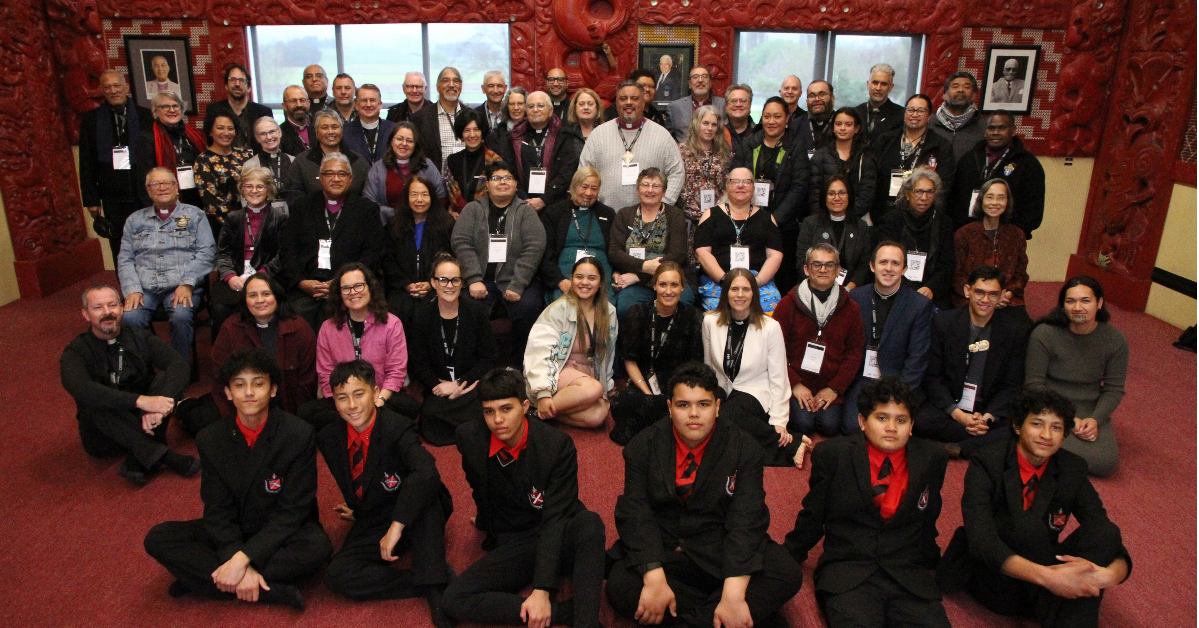The inaugural Anglican Indigenous Leadership Initiative got off to a rousing start as activities commenced with a pōwhiri at Te Aute College.
Months of planning came to fruition on Monday 25th September as Anglican leaders from several countries around the Pacific Rim converged in Hawke’s Bay for a week of sharing ideas, learning and kinship.
To set the tone for the summit, participants gathered at the college’s wharenui (ancestral house) to be welcomed with a pōwhiri (welcoming ceremony) including karanga, whaikōrero, waiata and kai.
Established in 1854, the Māori Anglican boys’ college is steeped in the traditions of both the Anglican Church and mātauranga Māori (ways of knowing) – thus an appropriate location to open the event. This duality of faith and culture is felt most keenly in the school’s whare wananga (house of deep learning). And it’s this location, and our country of Aotearoa New Zealand, that was chosen intentionally as a place that would inspire, support and cement the overall kaupapa of the AILI, according to Primate and Pīhopa o Aotearoa, Archbishop Don Tamihere.
“We have always wanted to gather here, in Aotearoa, as we feel like there is something about Māori culture that has value and message for other indigenous people” he said on Monday. “We’ve found an infrastructure that works to both protect our identity and survive in a colonised space.”
As is custom at a pōwhiri, local representatives welcomed participants to the whenua, with Ngāti Kahungunu kaumatua Jerry Hapuku, a Bishop of the Mormon Church, emphasising that although the group may have several differences, and speak many different languages, they are united in the love of the same God.
On behalf of the visitors, National Indigenous Anglican Archbishop of Canada, Chris Harper, voiced the sentiment of participants saying; “We come humbled, to stand in solidarity with all, so that our voices can show the world that the Creator can bring us together for one cause, one strength, one voice, one song.”
Following the theme, Primate of the Anglican Church in Aotearoa, New Zealand and Polynesia – Sione Uluilakepa – spoke of the mana (spiritual power) and connection shared between members of his congregation and those in New Zealand, before leading attendees from the Polynesian community in a beautiful roof-raising hymn.
Then, Archbishop Tamihere explained to guests that aswith many indigenous people, Māori traditions tend to be oral. The whare wananga, he went on, is a deeply systemised way of capturing Māori knowledge and philosophy, passing it on over many centuries and generations.
As a function of oral tradition, Māori have encoded deep meaning and understandings into the carvings, patterns and symbols within the whare wananga, he explained, as a way of camouflaging the learnings from those who do not prize them, while at the same time revealing them to those that do.
After discovering the meanings hidden within the walls of the whare wananga, many of attendees found their ancestors represented somewhere within the room – reinforcing the kaupapa of kinship.
Emphasising the importance of intellectual concepts and the quest for knowledge within Māori culture, Archbishop Tamihere shared the story told by the 12 pou that line the walls, explaining “when you enter the whare wananga, you start with intellectual development and then go on a journey with the end result that you flourish spiritually. So, while we are actively trying to develop your mind, we are really trying to enable your spirit.
“This is the brilliance of our ancestors.”
Finally, acknowledging that indigenous people haven’t always thrived in the hierarchical, structured type of gathering that is common within the church, Archbishop Tamihere encouraged participants to “lean into their cultures to find new ways of understanding, and new ways of being that might help indigenous people to flourish in a way that traditional structures have not achieved thus far.”
AILI continues this week in Hastings.
